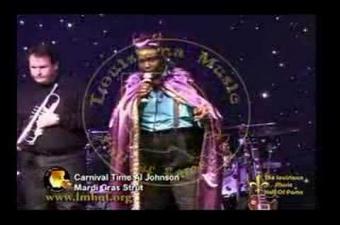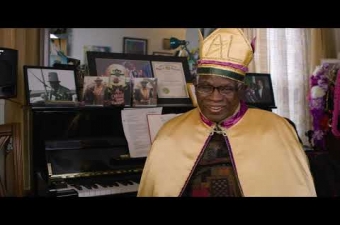The Green Room
400 N. GalvezNew Orleans LA 70119
The Green Room, a downtown nightclub, is familiar to generations of New Orleanians from the opening line of Al Johnson’s 1960 anthem “Carnival Time”:
The Green Room is smoking
And the Plaza’s burning down
Throw my baby out the window
Let them joints burn down
Tony’s Green Room and Joe Prop’s Plaza were clubs near North Claiborne Avenue, the main artery of Black Carnival celebrations (hence the subsequent lyric, “Claiborne Street is rocking from one side to the other”).
The producer of “Carnival Time,” Joe Ruffino of Ric and Ron Records, pressured Johnson to take out these references to appeal to white audiences, but Johnson, a relatively unknown 20-year-old, refused.
Recording the song was a slog, spread over multiple sessions at Cosimo Recording Studios. A rotating roster of studio aces, including tenor saxophonist James Rivers, who delivered a blazing solo, and pianist Mac Rebennack (before he adopted the Dr. John persona) didn’t take to Johnson’s idiosyncratic timing of the line “Right now it’s Carnival time.” But Johnson kept singing it as he felt it, and they eventually cut a classic.
The song, with its rollicking horn line and sing-along chorus, somehow took a few Carnival seasons to catch on. Even when it did, though, Johnson, didn’t see a dime: while Ruffino had failed to rewrite the song’s lyrics, he successfully wrote Johnson out of his royalties. As “Carnival Time” entered the Mardi Gras canon, Johnson joined the Army and drove a cab.
Al “Carnival Time” Johnson
Johnson was born in the Lower Ninth Ward, and started playing trumpet as a youngster before switching to the piano. The day after graduating high school in 1958, he cut the still-underappreciated “Lena,” featuring a saxophone solo from Herbert Hardesty and piano from Allen Toussaint, according to Tim Lyman in Wavelength.
The financial disappointments of “Lena” and “Carnival Time,” and a protracted legal battle for the rights to the latter, took a toll on Johnson. Especially after winning ownership of “Carnival Time” in 1999, though, he embraced his association with New Orleans’ most famous celebration.
In 2000, he re-released “Carnival Time” on his own label, along with “Mardi Gras Strut,” a new Carnival tune with a memorable horn line of its own.
When Hurricane Katrina hit in 2005, a section of the Industrial Canal wall breached a few blocks from Johnson’s house on Tennessee Street. Fortunately, Johnson had evacuated; the force of the onrushing water knocked it partially off its foundation, and it sat underwater for weeks. Johnson went on to record a poignant memorial for his home, “Lower Ninth Ward Blues.”
Johnson eventually resettled in Habitat for Humanity’s Musicians’ Village, and resumed his role as an avatar of good times, presiding as Grand Marshal of the annual Krewe of Red Beans parade, and lending his imprimatur to two signature cocktails, the Carnival Time and the Mardi Gras Strut.
The Green Room’s move to N. Galvez
In interviews in the 2000s, Johnson said that the Green Room was located just off of Claiborne Avenue, at St. Peter and Marais. In fact, the club opened in that spot in 1950, but moved 10 blocks away to N. Galvez and Conti in 1958.
Johnson told A Closer Walk that he wrote “Carnival Time” in “1959 and ‘60,” meaning that, while he later recalled the St. Peter location as his inspiration, when he enshrined the club in his song, it was here on Galvez.
Soon after the club moved, a rumor spread that proprietor Thomas Catalanotto had donated to the local White Citizens’ Council, a white supremacist organization. His customers, who were Black, began to boycott. But Catalanotto beat the allegation by hosting an event attended by prominent Black New Orleanians including Ellis Marsalis, Sr. (father of the pianist and jazz patriarch Ellis Marsalis, Jr.), who vouched for him.
An ensuing ad in the Black newspaper Louisiana Weekly touted Catalnotto’s investment in the new building (“ultra-modern, built of brick set off with fancy grill work”) which contained an upscale restaurant, lounge, and six apartments
In 1962, perhaps capitalizing on the growing popularity of “Carnival Time,” the Green Room advertised “breakfast served in the grand manner every morning after the [Carnival] balls.”
Later incarnations of the Green Room
The club was renamed Louie’s Green Room in 1968, but folks still called it Tony’s the following summer, when it was held up by three armed men including Albert Woodfox. In his acclaimed memoir Solitary, Woodfox recounts how prosecutors used false accusations stemming from that incident to convict him of a murder he didn’t commit, leading to nearly 44 years of solitary confinement.
In the 1970s and 80s, the restaurant and lounge carried on as Lionel’s and then Verlean’s Green Room. In 1990, Eddie Carter, a member of the Zulu Social Aid & Pleasure Club, who reigned as King Zulu on Mardi Gras in 1985, rechristened it King’s Row Lounge. He presented occasional live music from artists like guitar man Ernie Vincent, best known for his 1972 funk side “Dap Walk.”
The levee failures during Katrina flooded the building. Saxophonist Frederick “Shep” Sheppard was living in one of the rear apartments at the time–he was displaced to Arizona, where, sadly, he passed away before he could return to New Orleans. As the city rebuilt, Eddie Slack restored the building down to the tile floor as Slack’s Green Room, which presented brass bands and served as a second line stop until the mid-2010s.
By then, the surrounding neighborhood, evoked so memorably in “Carnival Time,” had transformed—the Lafitte public housing project was redeveloped with far fewer units, and several blocks of shotgun houses were bulldozed to a make way for a medical center. In 2017, the global investment bank Citigroup acquired the Green Room building, which retains its façade from 1958 but is empty inside.
The original Green Room at 1401 St. Peter had been torn down in the late 1960s to make way an exit ramp from the elevated expressway above Claiborne Avenue. That project devastated what was then one of the largest strips of Black-owned businesses in the South, but hasn’t stopped revelers from packing it on Mardi Gras Day, and rocking from one side to the other.
Videos

Al "Carnival Time" Johnson performing his signature song, along with "Mardi Gras Strut," at his induction to the Louisiana Music Hall of Fame in 2007.
Video by Louisiana Music Hall of Fame.
Al "Carnival Time" Johnson performing his signature song, along with "Mardi Gras Strut," at his induction to the Louisiana Music Hall of Fame in 2007.

Al Johnson recounts his experience of recording "Carnival Time" and then fighting for the rights to it.
Video by Crista Rock.
Al Johnson recounts his experience of recording "Carnival Time" and then fighting for the rights to it.







